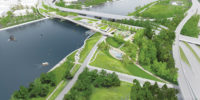When Paul Chan visited New Orleans for the first time in November 2006, the digital media and video artist expected to hear the sound of jackhammers and to see evidence of post-Katrina progress. He instead witnessed a far different scene: “The streets were still, as if time had been swept away along with the houses. Friends said the city now looks like the backdrop for a bleak science fiction movie. ... I realized it didn’t look like a movie set, but the stage for a play I have seen many times. It was unmistakable. The empty road. The bare tree leaning precariously to one side with just enough leaves to make it respectable. The silence.”
What the streetscape reminded him of was the setting in Samuel Beckett’s classic work Waiting for Godot. In the play, two men grapple with their nonsensical wait for a third; its philosophical reflection upon man’s uncertainty in the world seemed to Chan an apt metaphor for New Orleans’s precarious condition.
A year after this seminal visit, Chan, along with director Christopher McElroen and the Classical Theatre of Harlem, will stage the play during the first two weekends of November in two of New Orleans’ most devastated neighborhoods: the Lower Ninth Ward and Gentilly. Free and open to the public, the event is sponsored by the arts organization CreativeTime and intends to bring attention to the lack of redevelopment in these areas. Godot has similarly been staged by Susan Sontag during the war in Sarajevo, and in jails from San Quentin to Germany; this particular production, which will be performed on street corners, recalls New Orleans’ long history of street theater.
The play is just one aspect of a larger project to bring funds and art to New Orleans. Chan, who is known not just for his art but for his political activism, is teaching at Xavier University and at the University of New Orleans this fall. A fund he established will donate money to rebuilding efforts in both Gentilly and the Lower Ninth Ward.
Chan is hopeful that the performance’s significance will outlast the attention it briefly garners, but acknowledges how small a contribution it can make to the revitalization of the city where the wreckage still looms so large: “Whatever lasting effect there is, it will never compare to the lasting effects of the storm, the levee breach, and the malignant neglect of the city by our government in all quarters. Maybe the job of our work is not to last, but to shine, for a brief moment like fireworks.”




Post a comment to this article
Report Abusive Comment